
Retvizan was a Russian pre-dreadnought battleship built for the Imperial Russian Navy by the American Yard William Cramp & Sons, Russian shipyards being at full capacity. She was briefly assigned to the Baltic Fleet but soon transferred to the Far East in 1902, meeting her fate at Port Arthur. Sunk by siege artillery, she was refloated and reused by the Japanese until 1922 as IJN Hizen. A strange mix which resumes a strange fate for a rather straightforward, well-balanced and powerful battleship, probably the best Russia ever had in 1904.
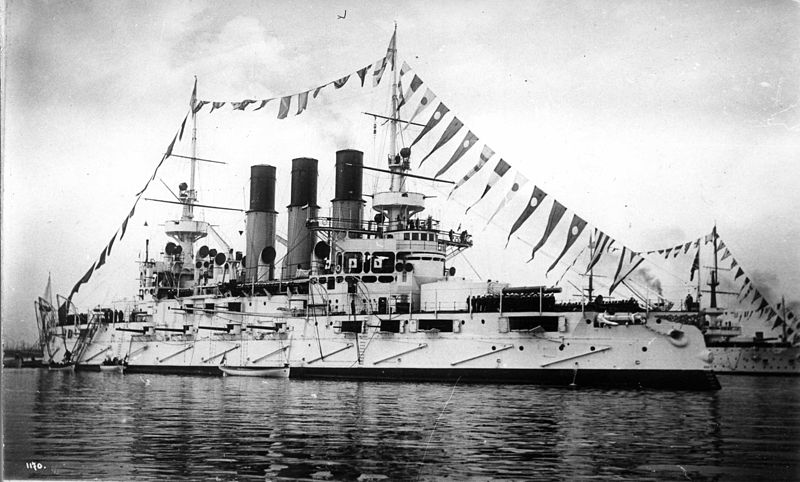
Retvizan (Ретвизан) was a unique case, a Russian battleship built in the USA. Named after Swedish “Rättvisan” (“Justice”) captured in 1790 and fifth and last of the name, while entering service, she was one of the world’s best representattive of the type, yet she remained sole in her class. Present in Port Arthur during the Russo-Japanese War, one of the best capital ship in the Russian squadron with Tsarevich, she was also unique for her partly Polish crew, including her commander. Half-sink by December 1904 by Japanese siege artillery, she was nevertheless recovered, repaired, standardized and back in Japanese service as IJN Hizen seeing WWI and discarded quickly afterwards.
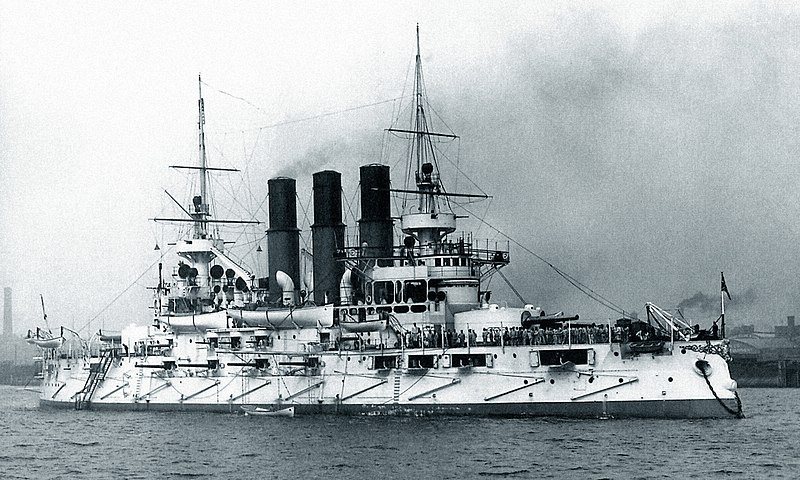
Context: Port Arthur
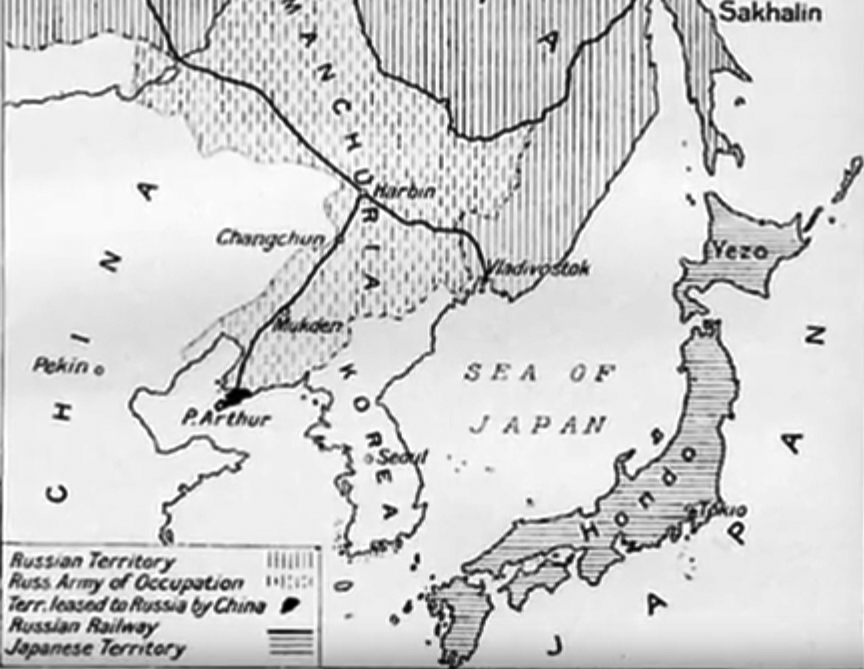
In 1898, a major naval plan approved by the Duma and wished by the new Tsar since 1894, Nicholas II, was setup to give the Russian Navy a true imperial, global reach. The peace treaty following the First sino-Japanese war was strongly moderated by Western Powers which, to balance the rapid ride of Japan in the area, gave concession to Russian of the the Liaotung Peninsula and a small fishing village in its midst, Lüshun, at the great frustration of the rising sun’s admiralty. Like Tsing-Tao it was seen as an unacceptable encroachment of the west in the reagion, and as the Germans, the Russuain admiralty decided to turn the village into a massive, modern fortress and naval base. For more, see the Port Arthur Fortifications. Indeed, Japane obtained it already by the 1895 Treaty of Shimonoseki, but this was opposed by the “the Triple Intervention” of France, Germany and Russia. The only compensations obtained were hardened reparations from China.
With this, the Russian Navy added the burdern (or chance?) of adding the Pacific to the Baltic and Black Sea as maritime access. This of course urged the need of a new, dedicated navy to defend it. In 1880 the port was a strategic location and the first appointed governor pressed the construction of fortifications, securing masive funds that would have been employed to built a new battleship. Krupp was hiored for the task, given what they did (at a smaller scale !) at Tsing Tao. The small village was soon unrecoignisable, wit a full-grown city surging from scratch, and the name changed to “Port Arthur”. Meanwhile, Russia also coerced a lease of the Liaodong Peninsula from China to surround its new gains with a defensive bulwark.
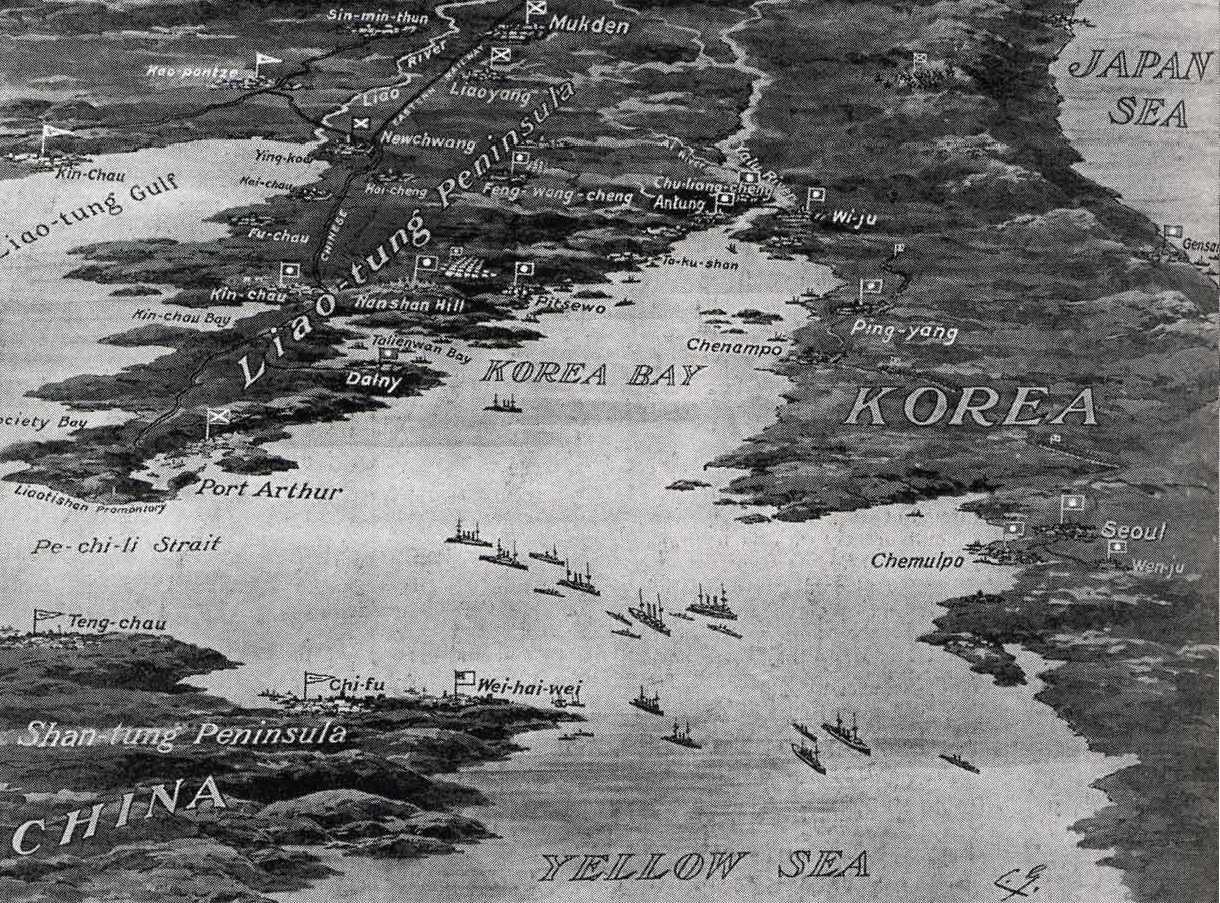
Port Arthur was seen as a major international cause for concerns, and the only “player” excluded for this game until then was Britain, which saw in a rather suspicious eye the manoeuvers of Russia in this area. There had been already a “russian scare” and naval race since 1885 in the region. Thus, in 1902, Anglo-Japanese Alliance was signed between Britain and Japan, limited and regional, to counter Russia’s expansion into East Asia. This was assorted by a gradual alignment in tactics and technical aspects of the new IJN to the Royal Navy that lasted until 1923.
With the support of the mightest Empire, Japan prepared its plans to retake Port Arthur.
The 1898 Naval Plan
Meanwhile, the Russians planned their new Pacific fleet. The 1898 naval program “For the Needs of the Far East” asked for three battleships but also a possible reinforcement from the Royal Navy in the area. Thus, Retvizan was one of these. The program evolved soon into a five-strong battleships force displacing 12,000 tons each. As the Russian Yards were already at full capacity, they wete to be ordered abroad. Well-informed by his local contacts at Moskow, Charles Cramp, from William Cramp & Sons in Philadelphia soon contacted Russian authorities on April 23, 1898 to secured the contract for a battleship (The Restvizan) and the cruiser Varyag to boot, promising very short delays.
Cramp’s offer was selected and the contract signed quickly in fact bypassing the whole competition procedure and raising concerns of corruption. The assessment by the Maritime Technical Committee (MTK) thus had to explain to other shipyards the emergency but the the circumstances of the agreement had never been explained by either Cramp have or the Russians to this day, all terms remaining secret to thus day. There was also some animosity between the MTK and Main Board of Shipbuilding and Supply (GUKiS) supported by Grand Duke Alexis.
When ordered, the design was not even yet ready and soon a commission headed by Commander Mikhail Danilevsky sailed for the USA on June 25, 1898 and settled at Philadelphia to supervise the design and construction. Armed with the guidelines of the ICC, he soon however banged heads with Cramp and reports backl to Moskow had him dismissed and replaced in November 22, 1898 by Polish commander Edward Szczęsnowicz, more accomodating. Overall the finalized design was considered successful but remained unique, Russia instead of ordering another turned to the French-built Tsesarevich and the derived, locally built Borodino class instead, in part due to the 1891 Franco-Russian alliance, Jeune Ecole’s appeal at the time plus court rivalries and personal ambitions.
Design Development at Cramp
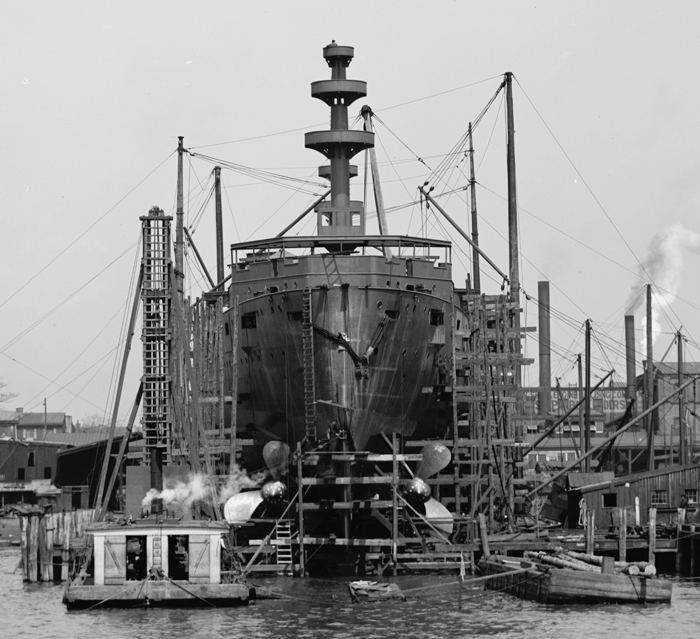
Construction at Cramp (cropped) via navsource.org
Cramp initially proposed a battleship modeled on the USS Iowa (BB 4, Launched 28 March 1896), but due its unsufficient speed and range, it was strongly opposed by the Maritime Technical Committee (MTK). The latter instead defined more ambitious requirements, with a top speed of 18 knots, cruising range of 8,300 nautical miles and all-Russian armament, precisely defined with four Obukhoff 305 mm (12 in).
The ICC proposed either a drivative of the Periesvet in development, or the new Potemkin also in development at the time. Documentation of the latter was provided to Cramp which worked out translation from metric and cyrillic to a more acceptable form for the engineers.
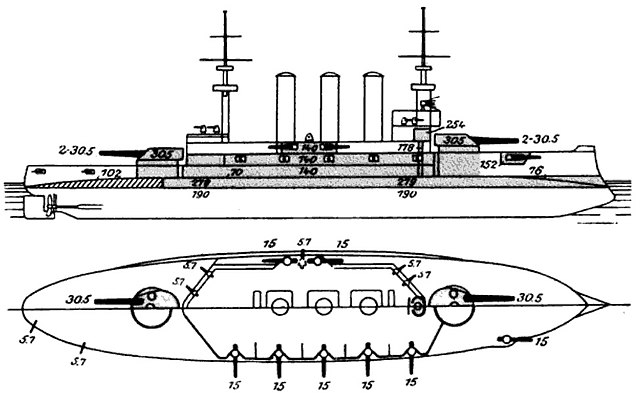
The very close USS Maine class designed at Cramp and laid down on 15 February 1899, a few months before Retvizan, on 29 July 1899.
Cramp also look out the Illinois class battleships as a base, mixed with features of the Russian designs. Indeed Cramp had been building USS Alabama of this class (launched 1898) but she was still slower and weakly protected, so the design was essentially beefed-up. The final result of the design had rather balanced characteristics, despite contract’s imposed dimensions and dsiplacement, a standard armament combined with perhaps best protection of the time, using the latest Krupp cemented armor steel (KMC) to boot.
Thick armor provided protection of the essentials against armor-piercing shells, with a well-designed citadel, and the upper sides with thinner armor well protected against high-explosive shells. Retvizan became not only the first Battleship in the USA to use Krupp steel, and it was so until the Maine-class battleships from 1899, drawing much experience from the Russian design and sharing it’s classic three-funnel silhouette. She was also the first modern US-built battleship solely for export. At the time, UK and France, the Italy, were seen as the main providers on the world’s stage.
Design of the class
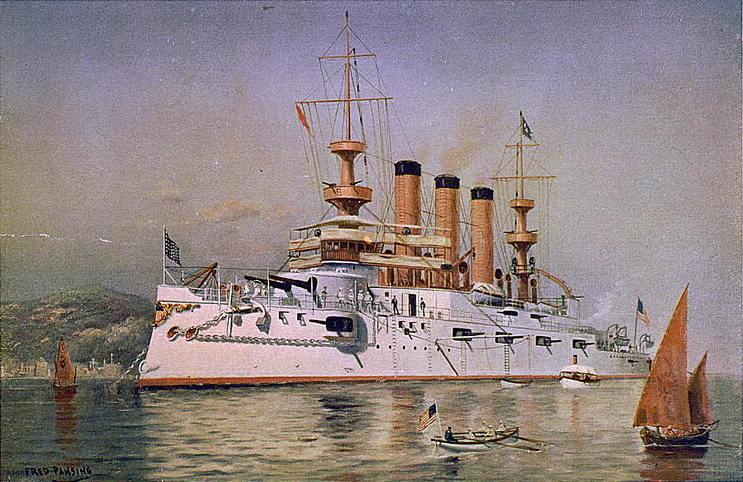
The Maine class, built a few months after Retvizan on a very similar design
Retvizan was seen as a superior design to all Russian battleships at the time, superior in some ways to Tsesarevich, with an even thicker main armor belt and turret armour, plus a rather good, passive anti-torpedo protection system, something rarely cared for to that extent at that time. It however had a smaller armor area, and the placement of the medium artillery in turrets initially was judged by many experts of the time quite modern but risky. This very much was the result of Russian insistance to choose Tsarevich as a basis for the development for standard Russian battleships. In the end, however casemates were chosen, with four in broadside, four in the superstructure corners.
Many naval historians argued that a fleet based on the arguably better Retvizan standard would have performed much better at the Battle of Tsushima than the Borodino-class. Compromises to reach greater speed indeed resulted in battleships that had even less armor than both Tsesarevich and Retvizan and were significantly overweight, resulting of crucial, additional protection shortcomings. Both the scheme and hull thickness of Retvizan’s armor recalled in many ways the UK-built Japanese Mikasa, future admiral Togo’s flagship and representing at the time a top achievement in battleship design.
IJN Mikasa only had a slightly better artillery protection, and was larger, unlike the unreasonably compact Russian restricted design. Potemkin ended largely similar to Retvizan, more a development from the Peresvet class, but still slower than the Cramp-built ship. The only drawback of Retvizan really was its Niclausse steam boilers conceded to Cramp for the propulsion, in spite of the adoption of standard Belleville boilers in the Russian fleet. Thanks to careful handling however they were not found that troublesome in later life but were ultimately replaced by the Japanese when in service on their side with more modern Miyabara models.
Hull and general design
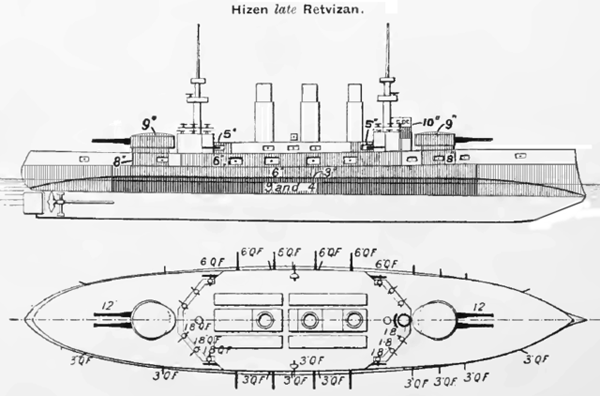
Retvizan as Hizen, Brasseys naval annual, 1915
Retvizan’s general pre-dreadnought architecture was respected, with a flush deck, two stage high, standard fore and aft 12-in main armament in two turrets, large admiship, symetrical superstrcture with two bridges, two military masts, and three funnels in between. The central superstructure’s walls protected scores of light anti-torpedo boat guns. The large military masts fore and aft supported light cannon platforms, something influenced by French Design and common in the Russian fleet at the time. But this was found on early US Battleships as well before the introduction of the corbel mast.
The forward superstructure started with very thich armored conning tower at the lower level, barely above the roof of the forward turret, and all necessary duplicated commands and handwheel. The upper floor supported a glazed, wooden paneled navigation bridge. The roof supported the “admiral bridge” with voicepipes and lookout scopes. Between the three straight funnels rann to walkways flanked by all the service boats, lifeboats and crane-launched cutters.
The bow had the customary reinforced ram and it was crown by lavish Russian Imperial armories. The engine room was protected on both side by coal bunkers, also typical of pre-dreadnoughts. Retvizan also had fuller hull lines with a ratio of 0.678, and was recoignised for her beter buoyancy reserve, allowing for furher additions, something unhead of on a Russian Battleship. Overloading after construction was admissible up to 335 tons, which saw both the high level of design excellence and workmanship developed at Cramp, added to the quick construction, in stark contrast to Russian practices (see later).
Armour protection layout
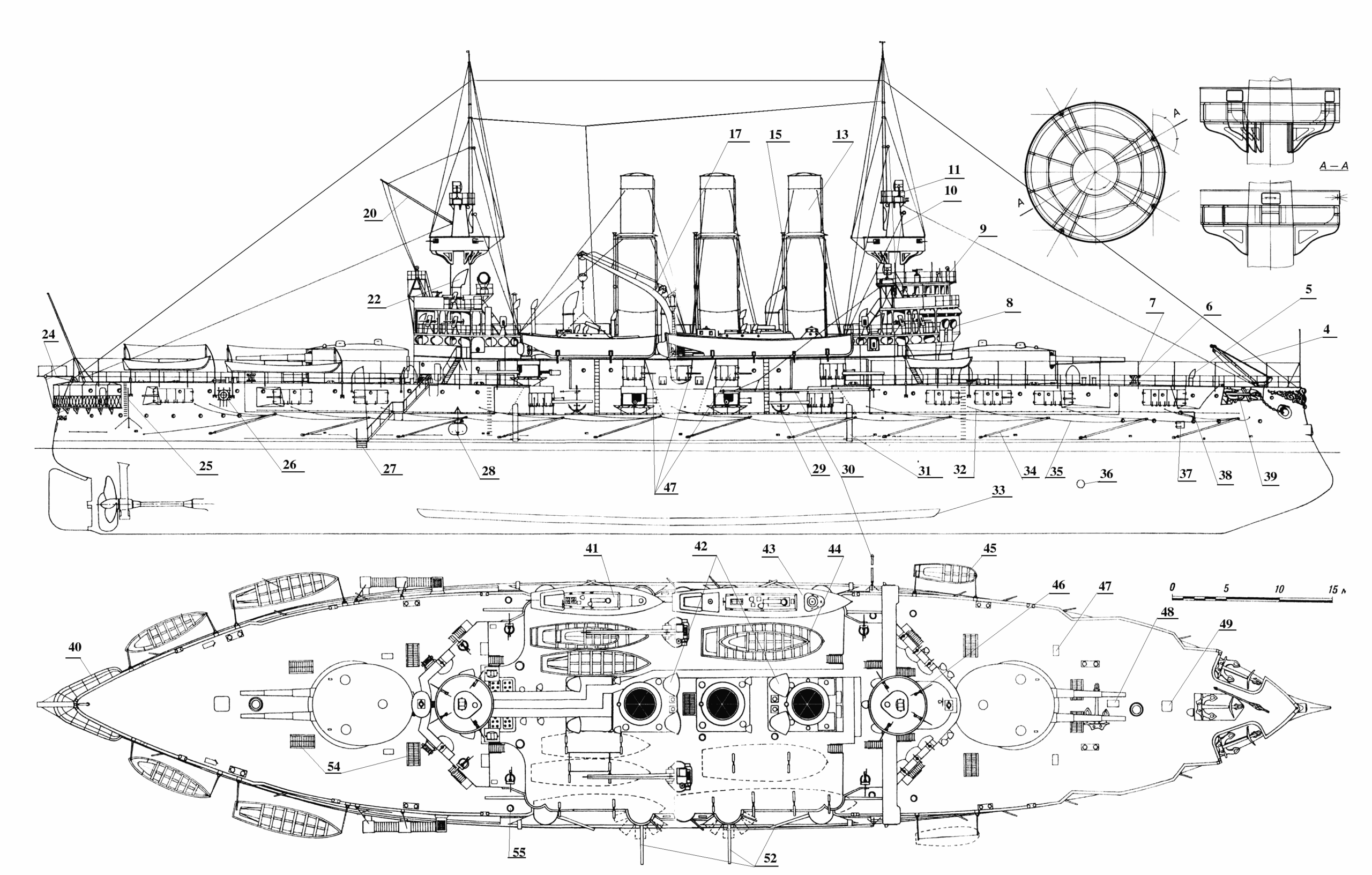
Solid 2-views reconstructed blueprint (Kombrig – src drawingdatabase.com)
Retvizan protection scheme was rational for a pre-dreadnought: The vertical armor was all made of the new, highly resistant Krupp steel manufactured by the Bethlehem Steel Company which acquired the licence for the Krupp process. The horizontal armor was made of nickel steel. This soon became the ideal solution for future US battleships designs. The total weight of Retvizan’s armor was 3,300 tonnes which amounted to 25.9% of the total displacement, quite a high value for the time.
-Side armor, waterline, 229 mm (9 in), tapered down to 127 mm (5 in) below on 78 × 2.14 m (255 x 7 fts).
-Upper armor belt 152 mm thick (6 in) on 78 × 2.3 m (255 x 7 ft 5 in).
-Outer Belt (bow and stern) 51 mm (2 in).
-Citadel, transverse bulkheads 178 mm (7 in) encasing the engine room, ammo rooms and barbettes.
-Secondary battery 152 mm casemates (6 in) 127 mm (5 in) side armo and 51 mm (2 in) shields.
-Inner armored deck* 51-63 mm (2.5 in) and 76 mm (3 in) at the bow and stern, out of the citadel.
-Main artillery turrets 229 mm (9 in), roof 51 mm (2 in)
-Main barbettes above the upper deck 203 mm (8 in)
-Main barbettes inside the citadel 102 mm (4 in).
-Conning tower 254 mm walls (10 in) but with wide observation slits.
*It was trapezoidal in cross-section and connected to the main belt’s lower edge
Powerplant
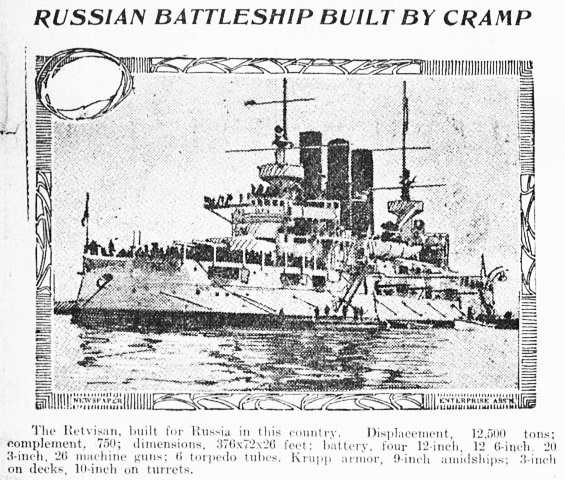
Propulsion was also classic for the time, with two vertical 3-cylinder triple expansion steam engines driving two four-bladed bronze propellers (diameter unknown). They were fed by the steam procuded by twenty-four Niclausse water-tube steam boilers working at a steam pressure 18 atmospheres, for a total output as indicated (ihp) of 17,111 HP for a design speed of 18 knots.
For range, the Retvizan had a total coal bunker capacity of 1046 tons in normal use, but up to 2,250 maximum when filling all void compartments in wartime conditions.
This enabled a range of 4,900 to 8,000 nautical miles at ten knots, also an achievement at the time and ideal for the Pacific. During her refit by the Japanese in 1908, she received instead new Miyabara boilers.
Armament
Main
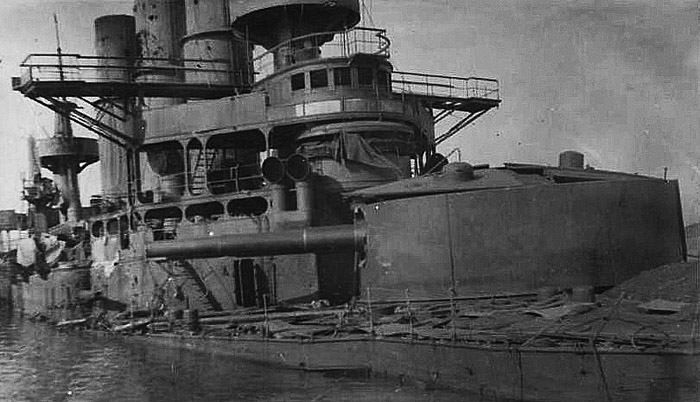
As photographed by the Japanese at Port Arthur
The Retvizan’s main battery consisted in four 305 mm/40 (12-in) guns manufactured by the Obuchov, housed by two twin turrets fore and aft. They had rounded, straight walls and a turtleback roof. They were also electrically powered, another innovation as the first Russian gun turrets of this caliber powered this way. This was enabled by the generally good US expertise in electric drive in general. Their barbettes were classic as the feed system down to the ammunition and powder charge rooms at two levels inside the citadel.
These guns were an old design in 1901: They derived indeed from the 1886 Krupp 12-inch/35 adopted and produced locally from 1891 for Chesma and subsequent Russian Battleships. It became a standard for all pre-dreadnoughts, including the postwar Pervozvanny class, despite their largely obsolete design post-1905 despite a much better rate of fire of 2 rpm.
They weighted 42 tons and the barrel measured 12.192 m. They managed between 0.7 rounds and one per minute, firing either the AP or HE “old model” both 731.3 lbs. (331.7 kg) with a 220.5 lbs. (100 kg) propellant charge and 2,598 fps (792 mps) velocity. She probably carried 60 shells per gun (240 total), as Tsesarevich.
(More on navweaps)
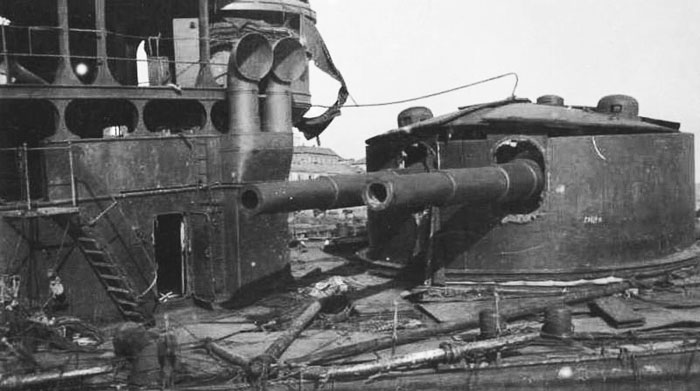
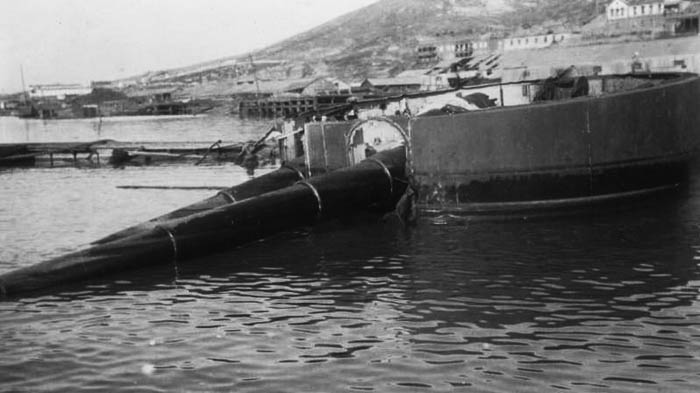
Secondary: 12x 6-in/45
The secondary battery was of Franco-Russian origin, twelve single 152 mm/45 (6-in) or “152 mm 45 caliber Pattern 1892” Canet guns in casemates: Four per side on the battery deck, covering each angle, and the remainder in broadside along the amidship section of hull battery deck. Manufactured at Obukhov in Perm, these guns used separate QF ammunition, weighting 41.4 kg (91 lb). They could elevate -6° to +25°, with a rate of fire from 2–7 rpm, muzzle velocity of 792 m/s (2,600 ft/s) and max range of 15.5 km (9.6 mi) at max elevation. They were a standard equipping all pre-dreadnoughts and cruisers of the Russian Imperial Navy.
Tertiary Armament
Tertiary, anti-TB armament comprised the following:
-Twenty 75 mm guns (3-in) in unarmored casemates, seven on both sides of the battery deck, three in the superstructure walls. These were also Canet/Obukhov guns, “75 mm 50 caliber Pattern 1892”, firing fixed QF ammunition weighting 4.9 kg (11 lb), elevating -7° to +20° for a 12-15 rpm ROF, 862 m/s (2,830 ft/s) velocity, 7.8 km (4.8 mi) range.
-In addition they were procured twenty-two light 47 mm Hotchkiss QF guns. They were placed on the central superstructure roof, wings of the fore and aft bridges, and four each on both military mast fighting tops.
-There were also six 37 mm Hotchkiss guns, and two (later four) Maxim heavy machine guns installed on the bridges’s wings.
Torpedo Tubes
As customary at the time, Retvizan had six 450 mm torpedo tubes: Two fixed, above water at the bow and stern (to cover in chase and retreat) and two fixed, submarine broadside, not below the belt but in front of the citadel and forward barbette port and starboard, plus two on mobile mounts, above water in front of the aft barbette and citadel’s aft bulkhead. 17 torpedoes were stored.
Landing Party
Artillery also comprised two dismountable (if a landing party was needed) Baranowski 63.5 mm (2.5 in) landing guns on optional wheeled carriages. There were two hundred rifles on board for sailors to supplement naval infantry in that case, and enough boats to land and resupply an important contingent. The party could be led by the two steam cutters, each armed with a 380 mm (15 in) torpedo tube (also to act as impromptu TB in harbor operations) and forward-mounted 47 mm (1.85 in) cannon, plus two smaller cutters equipped with unrpopelled min-torpedoes. There also was a provision aboard for forty-five naval mines laid by both cutters. This enabled quite a range of tactical capabilities, at least on paper.
Construction of Retvizan
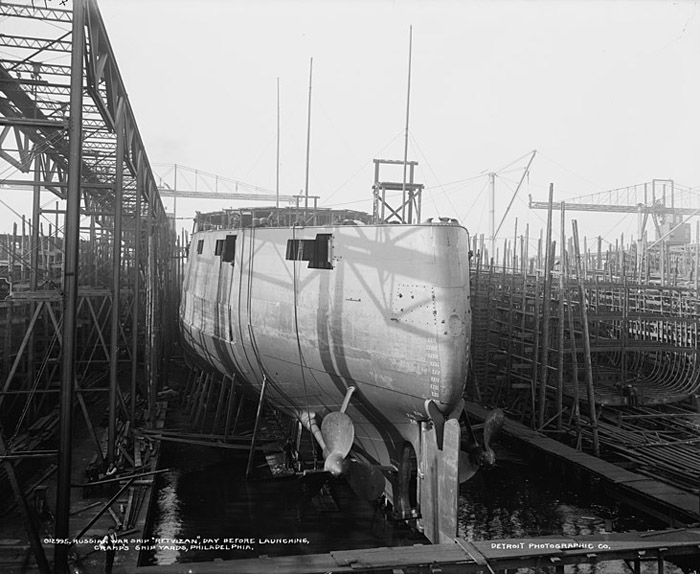
Restvizan close to launch a Cramp
Construction of the battleship began in Philadelphia, in the fall of 1898 (hull number 300) with her official keel laying celebrated on July 29 1899, after 1000 tons of hull structure had already been assembled. The hull was launched on October 23, 1900, and the yard, true to its promises procured a fast pace. However construction was delayed due to documentation change on the Russian side, preferring to focus on the cruiser Varyag. It was compounded further by delays in procuring the artillery turrets sailing from Russia and made by Metallichesky Plant in St. Petersburg.
On October 21-24 1901 the ship 1901 was completed and started her acceptance tests. Construction cost was $4,360,000 at the time. The shipyard alread tested her and fixes dome noticed defects until January, and further sea trials showed more issues, but not that much and in the end, Retvizan was accepted for service on 23 (March 1902. It was a record among Russian battleships and no contractual penalties were asked for. Quality overall was also excellent, and in addition to the total 8,628,840 rubles paid by the Tsar was added $489,839 for additional work and Krupp armor purchase, for a grand total of total $4,847,839 which is about 123 million modern dollars.
The name was taken from the Swedish 64-gun ship of the line “Rättvisan” (Justice), captured on June 22, 1790 by the Frigate Venus during the Battle of Sveaborg. She was pressed into service in the Russian fleet with her name russified as “Retvizan” or “Rietwizan”, commemorating victory over the Swedes, name already sported by two 74 cannons and a 84 cannons steam frigate prior to her.
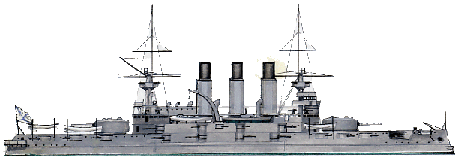
Retvizan specifications |
|
| Dimensions | 107 x 20.4 x 8.4m (351 x 67 ft x 27 ft 7 in) |
| Displacement | 10,206 long tons (10,370 t) standard |
| Crew | 24 +417 |
| Propulsion | 2 shafts TE engines, 12 Cyl. boilers, 9000 ihp |
| Speed | 15 knots (28 km/h; 17 mph) (16 knots as designed) |
| Range | 3,050 nmi (5,650 km; 3,510 mi) at 10 knots |
| Armament | 4 x 305 (2×2), 8 x 152, 14 x 47 mm, 12 x 37 mm, 6 TT 450 mm |
| Armor | Waterline belt: 12–16 in (305–406 mm), Casemate: 5 in (127 mm), Turrets: 12 in (305 mm), CT: 10 in (254 mm) |
Read More
Books
Campbell, N. J. M. (1979). “Russia”. In Chesneau, Roger & Kolesnik, Eugene M. (eds.). Conway’s All the World’s Fighting Ships 1860–1905. New York: Mayflower Books. pp. 170–217. ISBN 0-8317-0302-4.
Forczyk, Robert (2009). Russian Battleship vs Japanese Battleship, Yellow Sea 1904–05. Botley, UK: Osprey. ISBN 978-1-84603-330-8.
Friedman, Norman (2011). Naval Weapons of World War One: Guns, Torpedoes, Mines and ASW Weapons of All Nations; An Illustrated Directory. Barnsley, UK: Seaforth Publishing. ISBN 978-1-84832-100-7.
Lengerer, Hans (September 2008). Ahlberg, Lars (ed.). “Hizen (ex-Retvizan)”. Contributions to the History of Imperial Japanese Warships (Paper V): 57–59.(subscription required)(contact the editor at [email protected] for subscription information)
McLaughlin, Stephen (September 2008). Ahlberg, Lars (ed.). “Retvizan”. Contributions to the History of Imperial Japanese Warships (Paper V): 60–63.(subscription required)
McLaughlin, Stephen (2000). Preston, Antony (ed.). The Retvizan: An American Battleship for the Czar. Warship. Vol. 2000–2001. London: Conway Maritime Press. pp. 48–65. ISBN 0-85177-791-0.
McLaughlin, Stephen (2003). Russian & Soviet Battleships. Annapolis, Maryland: Naval Institute Press. ISBN 1-55750-481-4.
Silverstone, Paul H. (1984). Directory of the World’s Capital Ships. New York: Hippocrene Books. ISBN 0-88254-979-0.
Warner, Denis & Warner, Peggy (2002). The Tide at Sunrise: A History of the Russo-Japanese War, 1904–1905 (2nd ed.). London: Frank Cass. ISBN 0-7146-5256-3.
Westwood, J. N. (1986). Russia Against Japan, 1904–1905: A New Look at the Russo-Japanese War. Albany, New York: State University of New York Press. ISBN 0-88706-191-5.
Siergiej A. Bałakin (С.А.Балакин): “Bronienosiec ‘Rietwizan'” (Броненосец «Ретвизан»), Morskaja Kollekcja
Lech Trawicki: “Polacy na Rietwizanie” w: Morza, Statki i Okręty 3/2004
Links
https://books.google.fr/books?id=-PoOAAAAYAAJ&pg=PA3&redir_esc=y
http://ship.bsu.by/ship/102461
https://en.wikipedia.org/wiki/Russian_battleship_Retvizan
Model Kits
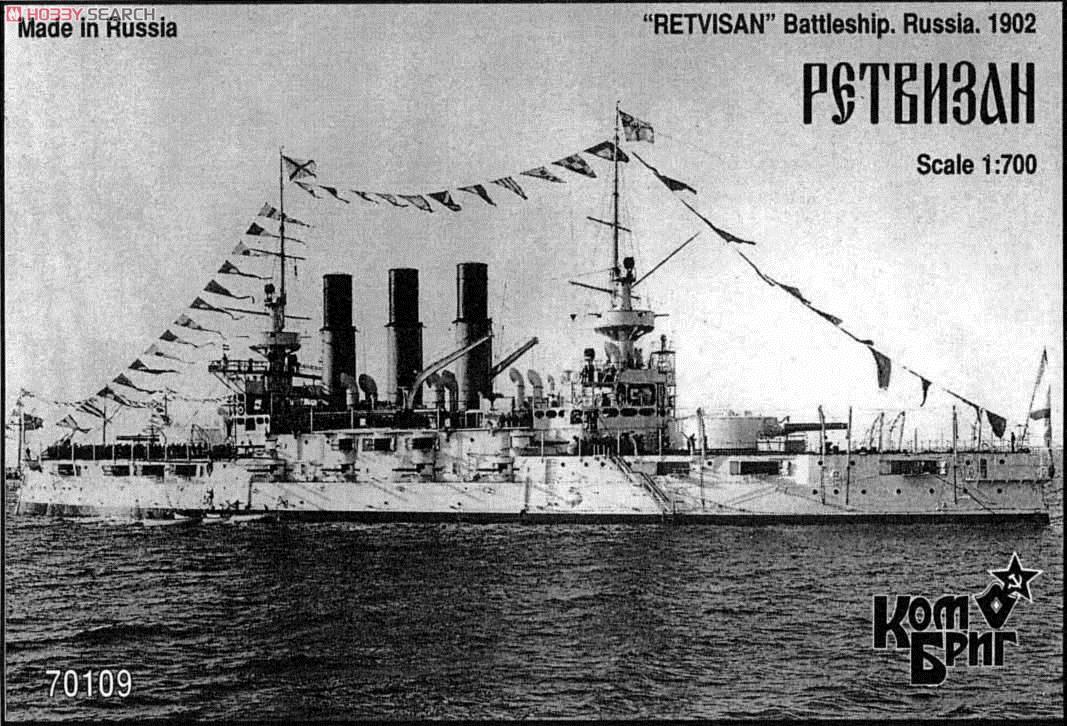
Not much to go along but the always solid 1:700 and 1:350 Kombrig kits. There was also an Old Glory Miniatures 1:600, and Fairy Kikaku 1:700. Scalemates query.
There are also a few 3d renditions out there like this one on artstation.
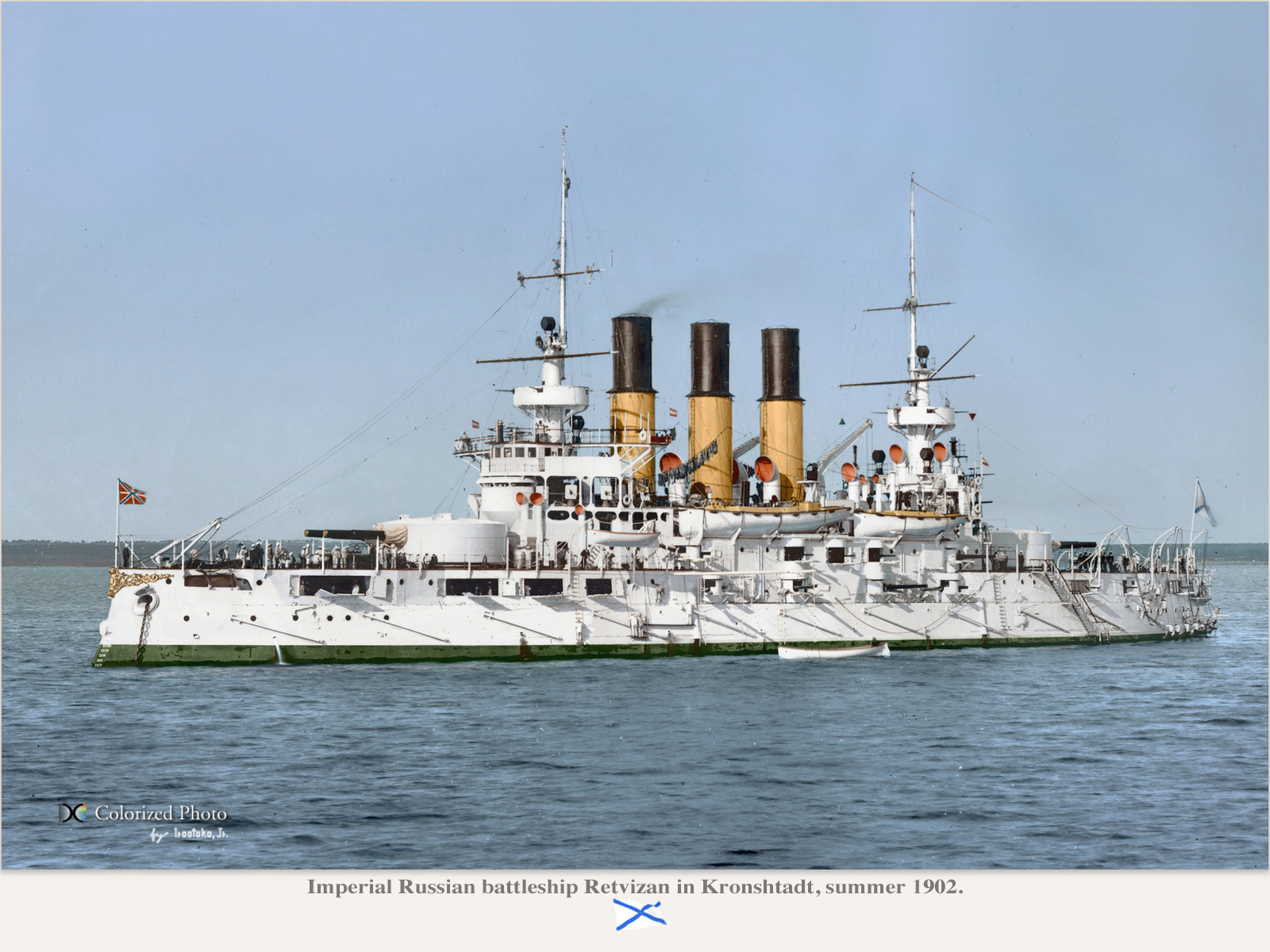
Retvizan in Kronstadt, summer 1902, freshly commissioned. You can’t go wrong with Irootoko JR’s colorizations, always drop dead gorgeous.
Retvizan’s Career 1901-1923
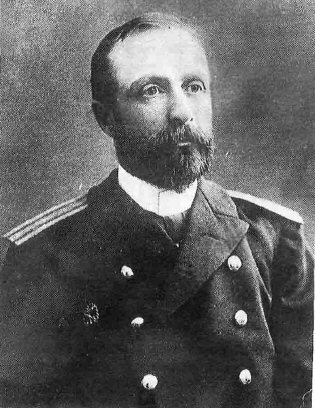 Her first and only commander was Polish-born (then born in Arkhangelsk from an ethnic Polish nobility) Captain 1st Rank Edward Szczęsnowicz, which follow her after completion and up to her commission. She started her initial training and shakedown cruise with her Russian crew on 13 May UT (30 April Greg. Calendar) 1902 on the US east coast for the Baltic sea via the Atlantic, north sea via the channel and Skagerrak strait, arriving late June at Kronstadt.
Her first and only commander was Polish-born (then born in Arkhangelsk from an ethnic Polish nobility) Captain 1st Rank Edward Szczęsnowicz, which follow her after completion and up to her commission. She started her initial training and shakedown cruise with her Russian crew on 13 May UT (30 April Greg. Calendar) 1902 on the US east coast for the Baltic sea via the Atlantic, north sea via the channel and Skagerrak strait, arriving late June at Kronstadt.
On her way a boiler failure (pipe burst) was thez only incident noted as the crew was not accustomed yet to the new boilers, which cost the ship the live of three stokers, which died from burns. Upon arrival, she was sent to take part on front of Nicholas II to a grand fleet review in Revel (now Tallinn), with honored cousing and guest German Emperor Wilhelm II. The latter also was building a new fleet and quite interested by such US-built design. During her first post-fix overhaul she was given a radio station, and tests were carried out in September with it, as well as as the first Russian RAS (Resplenishment at Sea) with coal from transport ship “Asia”, a former cruiser, using a special conveyor. This operation was to test a long voyage to the far east in full autonomy.
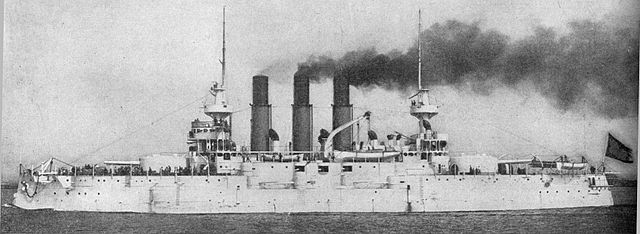
Retvizan at sea in the Baltic, 1902.
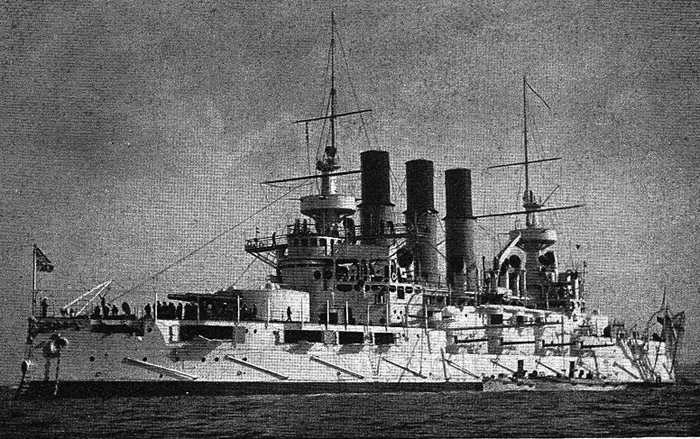
The future Pacific squadron gathered at Viborg. Photo by Apostoli Golike.
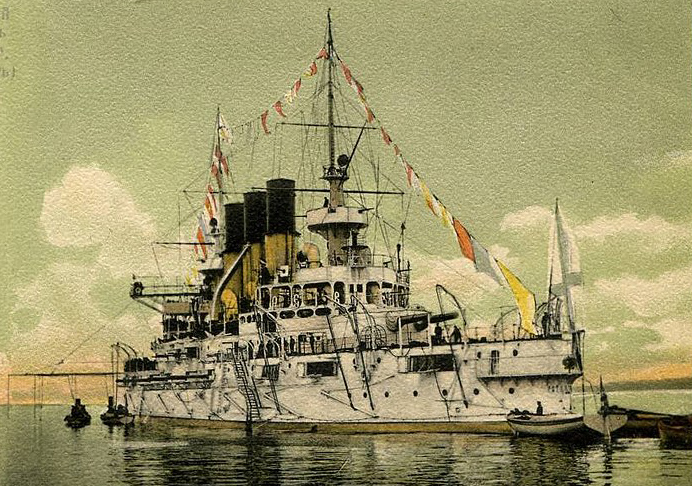
Retvizan during her long trip: Here in Pirareus, Greece (Postcard)
By November 13 (October 31), 1902, Retwizan was assigned the new Pacific Ocean Squadron formed under command of Rear Admiral E. Sztakelberg from Liepāja to sail for the far east. It departed for a long cruise through the Skagerrak again, channel and gulf of Gascony, then Spanish coast, Gibraltar, crossed the Mediterranean, stopped at Piraeus, Greece, and arrived at the Suez Canal, crossing it to the Indian Ocean. She arrived eventually via Nagasaki to Vladivostok on May 4 (April 21), 1903. The long trip was almost without incident, notably in the new battleship’s machinery.
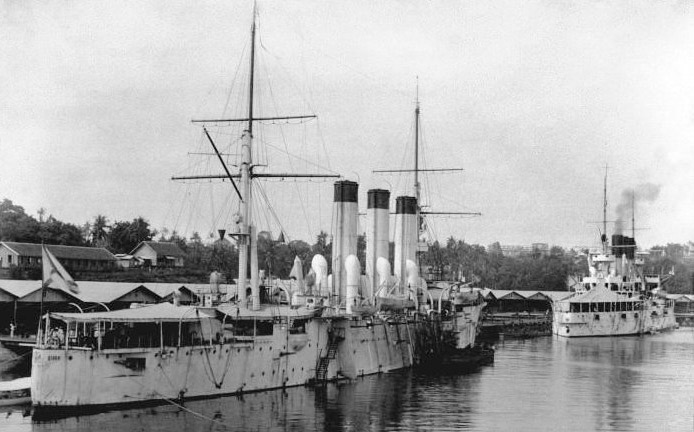
On her way to the Pacific, Retvizan in Sabang harbor, Indonesia to recoal.
The new Pacific squadron comprised also the battleship Pobeda (Sevastaopol class), the cruisers Bogatyr, Diana, Pallada, Askold, Novik and seven destroyers. Varyag (also built at Cramp) was still awaited. Retvizan escorted by Pallada were the first to enter the port, the other following later. In August 1903, Retvizan stayed in Vladivostok, becoming flagship, Vice Admiral Oskar Stark. In late 1903 her colorful peacetime livery was replaced by her typical far east dark “olive gray” better to blend with the background. As winter came out, Retvizan sailed to Port Arthur, better protected against the harsh weather and ice. On 31 January 1904, tensions between Russia and Japan escalated but she was not prepared for war.
The Port Arthur Siege
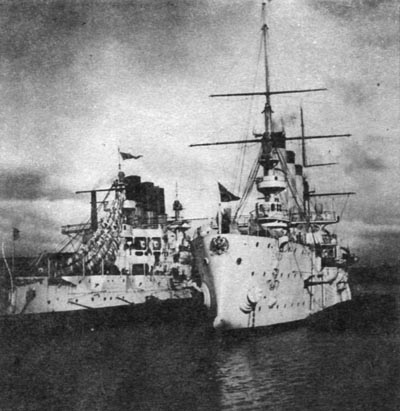
Retvizan and Pallada in 1902, prewar. They were the first to enter Vladisvostock and stayed together in Port Arthur.
During the night of February 8/9 (January 26/27 Greg. cal.), Japanese destroyers entered the roadstead of Port Arthur and launched a torpedo attack. At 11:35 p.m. Shirakumo’s torpedoes (presumably) hit Retvizan, which soon was flooded by 2,200 tons of seawater. Her captain ordered to raise steam and attempted to have her moved to the inner roadstead but se she soon was soo loadse for this, opted to have her running aground, unfortunately also partially blocking the entrance to the harbour. Five sailors died in explosion of the broadside underwater torpedo tube, with another another damaged after the impact. The following day saw a full-on sea battle with the Japanese fleet which arrived, but Retvisan was only capable to operate her secondary battery, and she only was able to fired two 6-in shells.
As the Japanese departed to blockade Port Arthur, and both sides were now planning minelaying operations, intense work commenced to refloat the damaged and half-sunken ships. Pumps were reactivated and used to lighten up Retvizan while considerable efforts were made to get her out of the shoal. These operations were unsuccefful however, and she was used as a floating battery at the entrance to the harbour by default. Her guns were all made operational again and small ships managed to surrounded her by anti-torpedo nets to sustain more Japanese attacks.
During night reconnaissance sorties from Japanese destroyers she had the occasion to spot them using her projectors and launching flares. On the night of 23/24 February 1904 she was the centerpiece of the force that repelled a new torpedo attack by four destroyers. The Japanese came back with two old ships to be sunk in the entrance to the harbor to block it and Retwizan assisted by the destroyers Storozhevoy and Steriegushchij, steamboats and coastal artillery destroyed these by concentrated fire. One of these, Hokoku Maru, attempted to ram Retvizan, but without success. In all during this attack she fired two 12-in (305 mm) shells and 71 6-in (152 mm), 152 of 3-in (75 mm) and 590 of 47 mm, 120 of 37 mm (1-2 Pdr). Commander Szczęsnowicz was awarded for this night action, also coordinating the fire, the Order of St. George, IV Class. Numerous crew members also received decorations. At last, the battleship was pulled free from the shoal by March 9, using a caisson and rescue tug “Siłacz”, her bow guns removed to light her.
She then was towed to the better protected inner roadstead, under the fortifications. There she was repaired, a difficult task due to the absence of adequate facilities and dock of the right size, unlike in Vladivostok. Underwater work was done using a tailored caisson attached to her sides with water pumped out, designed by captain Jerzy Zaborowski. The damage was quite extensive with a gush to cover of 15 m² and a grand total of 37 m² of framing and plating needed to be replaced.
On March 11, operations were complicated by plunging fire on the blind, from over the hills by the Japanese squadron. 154 main battery shells (12-inches) fell around Retvizan which took a port near-miss. It was enough to blow up the caisson, flooding her side under repair again. The starboard side being also hit, but the shell failed to penetrate her armour due to the steep angle. To keep her from sinking, she was placed head-first on the shallows, but still five died in this attack and flooding. Four secondary guns were removed and placed on a hill looking at the inner harbor, as a coastal battery.
On March 22, the battleships IJN Yashima and IJN Fuji resumed indirect fire, but Retvizan and Pobeda started to reply, corrected by telephone observers for the hilltop. Retvizan could only use her stern turret on her position, grounded, but with an artificially increased angle of elevation. One of her shells near-missed Fuji and this was enough for the Japanese to withdraw. Soon quiet again, engineers started to built a new, improved and larger caisson, and resume repair until June 4. The plating was partially constructed and pre-assembled on shore by chief construction engineer, shipbuilder Romuald Świrski.
Retvizan now fully operational again retook her place in the squadron and under orders of Moskowa, prepared for the squadron breakthrough attempt from Port Artur on 23 June 1904. However Japanese forces waited for them after afted an intense artillery duel, they folded back to Port Arthur. This was followed by yet another night torpedo attack as they just returned. On July 27 Retvizan accompanied by the cruisers Bayan, Pallada, Novik and gunboats started to fire on coastal targets, and too part in the fortress defence as land operations by the Japanese progressed swiftly despite fierce resistance. They also took part in a long-range skirmish with the armored cruisers Kasuga and Nisshin (Garibaldi class, freshly built in Italy), largely inconclusive. On July 30 Retwizan suppoted several bombardment of Japanese land forces from the inner roadstead.
Continuation Operations

Artist rendition, from pinterest, uploaded by Mark Beerdom
From August 6 1904, the Russian ships stationed in the inner roadstead became targets from newly landed Japanese 120 mm field howitzers, in indirect fire but corrected from freshly (with huge cost) captured observation points. On August 9, Retvizan was hit by seven shells, one of which penetrated her broadside under water. She was floooded with 400 tons of seawater. After patching up, she took part in the second breakout attempt resulting in yet another particularly fierce exchange with the Japanese fleet: The Battle of the Yellow Sea on July 28. Durng the fight, Retvizan lost two 6-in guns, three 3-in guns, two 2-pdr and all her 1-pdr and machine guns due to explosive shells. She only could reach 13 knots with 250 tons of water in flooded compartment and the same for counterflooding on the other side, making her an easy target.
Retwizan was second in line behind Csesarevich (flagship) and the duel lasted several hours as Vice-Admiral Witgeft really wanted to get through. But he was soon killed with all his staff when Tsesarevich’s bridge was hit by a heavy shell. Without direction, the line soon broke apart. Retvizan tried a brave move in order to protect the withdrawal. It went directly for the Japanese line, her ram pointing out in the dorection of the cruiser Nisshin, and thus attracting a “T-style” withering, concentrated Japanese fire, but drawing attention away from the rest of the squadron. Commander Szczęsnowicz was soon slightly wounded by a shrapnel via a crack in the conning tower. When he was sure that all the ships had safely returned back to Port Artur he directed a return course, alone, also driving off on her way approaching Japanese destroyers three times during the night. She crawled back, all flames extinguished but with six men killed and 38 wounded in Port Artur.
In the course of the Yallow sea Battle, she was hit by no less than 21 up to 23 heavy shells, notably a broadside penetration above the waterline causing extra flooding. Her forward gun turret aslso took a hit that jammed her ring mount, she lost another secondary gun, two 3-in guns, six 2-pdr, and all her searchlights. But overall damage was not serious enough to write her off. She still kept her aft main turret and most of her artillery and spent 77 main battery rounds at the Japanese (including 73 HE shells) plus 310 of secondary guns, and 341 of 3-in, 290 of 2-pdr (47 mm) guns, showing she went close enough to bring them to bear.
Final Battle and Capture
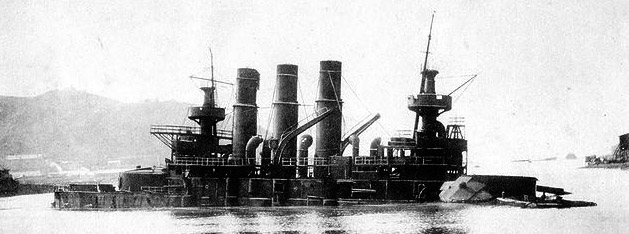
Retvizan half-sunken after being pounded by Japanese 280mm howitzers.
After the failure of the last attempt to breakout, the Russian squadron resuled indirect fire from the inner roadstead. It was concentrated at Japanese land targets with many more medium and light guns dismounted and transferred to fight off the siege from land fortifications around the fortress. On August 17 and up to September 5, Retvizan made 14 bombardments on advancing Japanese forces. Japanese indirect fire also resumed, but she was not hit once. From October 2, however, the Japanese ânaged to bring their heaviest howitzers, 280 mm Krupp guns, on top of the freshly captured hills. They started to fire on the ships this time in direct sight. Several soon hit Retwizan and the fire went on for weeks, but still the battleship escape major damage while being all along the new flagship for Rear-Admiral Robert Wiren (Robert Reinhold von Wirén, a Baltic German career naval officer).
On December 5, 1904, after nearly a year of war, the Japanese captured the Highest hill overlooking the port, and brought better observation posts for the artillery. Fire became deadly accurate eight 280 mm landed directly on the battleshuo, in the Western Basin, one penetrated her side under water, the other devastating ehr superstructures or her weather deck. She still only had two injured. On December 6, shelling intensified and she received fourteen 280 mm shells, six 150 mm ones (One sailor was killed, six injured). Three main shells penetrated her sides under water, flooding her until she sat on the bottom on the 16th. Her captain order to abandon ship. One the 7th she was written off the list. Before the capitulation on January 2, 1905 sailores returned under orders with officers to blast with explosives any sensitve equipments that could not be carried out and dropped to the sea or hidden. Including her remaining main turret.
The siege of Port Arthur was not over yet. Most surviving crews of the sunken battleships went on using steamboats, minelaying and minesweeping the area or perform guard duty and attempting dangerous coastal sorties, the first by one of Retvizan’s steam cutters, attemopting to attack the ships anchored at Kerr Bay (north of Dalian Harbour). On the 10th of May ths cutter however was grounded and wrecked on uncharted rocks. By the end of May, the other’s battleship cutteralong with two others from the cruisers Askold and Sevastopol also operated in Dalian Bay, firing at Japanese troops on May 26. On the following day while back to port they were intercepted by Japanese destroyers, fired upo, and then grounded by their crews which managed to escape ashore.
On the night of December 5 Midshipman W. Dmitriev (cutter No.2) managed to send a torpedo on a Japanese destroyer, claiming a hit. On January 1, also by night, his cutted managed to escape from the blockade, reach the Chinese port of Yantai, and the crew and boat interned. After the war the heroic cutter from Retvizan served in Vladivostok until 1922, sinking when taking part in the evacuation of “white Russian” forces. The crews that were taken prisoners after the capitulation comprised Commander Edward Szczęsnowicz.
Second life as IJN Hizen
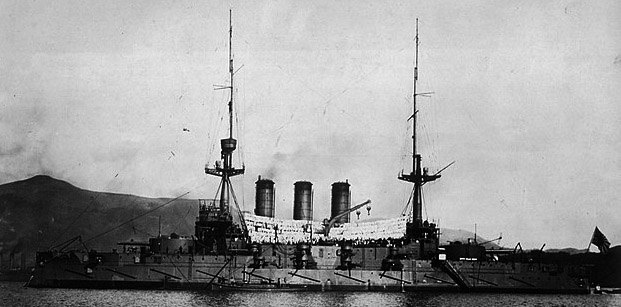
Battleship Hizen in full regalia, date unknown. She had been painted on the usual dark Grey of the IJN at the time.
After the capture of Port Arthur, Retvizan was formally captured by the Japanese which setup a refloating party. She was ultimately raised on 22 September 1905, repaired back in Japanese, after being towed there and given the new name of “Hizen”. After full repairs and standardization to IJN equipments at Port Artur and Sasebo she was completely operational by November 1908, assorted with a full commission ceremony there. She only was slightly modernized, with her Niclausse replaced by brand new Miyabara boilers, shortened funnels with a different shape. British Armstrong stadard light guns also replaced her original artillery only for the 3-in guns. She kept her Obukhov secondary and main guns, using her remainder ammunition supplies.
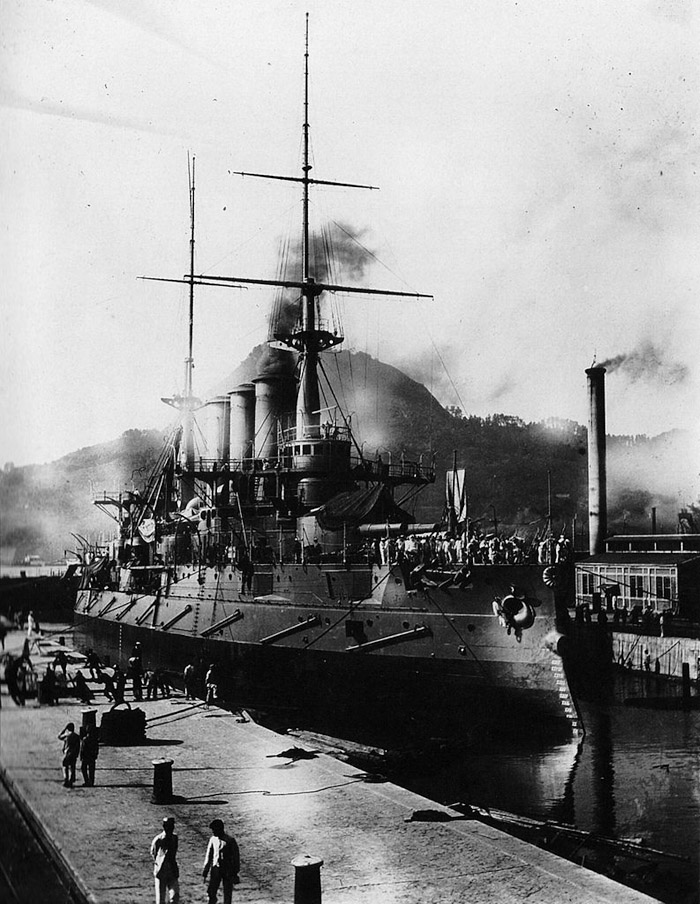
Hizen in Sasebo, 1908.
Her suebsequent service in 1909-1914 was not thrilling. She multiplied fleet training exercizes, although considered too slow for the new fleet standard in 1912, and sent to a second line sqaudron comprising mostly former Russian captured battleships and cruisers. She had therefore a limited participation in World War I. By the autumn of 1914 sshe took part in the unsuccessful search for Von Spee’s German East Asia Cruiser Squadron fleeing the Central Pacific, escorted by the armored cruisers IJN Asama and Izumo. On October 15, 1914, with Asama alone, IJN Hizen approached Hong Kong, where the German gunboat Geier was docked, but the latter deterred the Japanese to capture her and she was forcibly interned (several of the Bainbridge class destroyers we seen recently took part in this event). From 1918 to 1921, Hizen took parft in the multinational intervention in eastern Russia, going to Vladivostok several times, escorting troopship there in support of the White Russians, and later proceeding to their evacuation.
On September 1, 1921, Hizen was reclassified as a coastal defense battleship. In 1922, with the Washington treaty being discussed, she was decommissioned, disarmed at Sasebo to free tonnage. On September 20, 1923, she was stricken from the lists, becoming a target ship and sunk on July 12, 1924 in Bungo Strait, in a main gunnery exercize by several battleships.



 Latest Facebook Entry -
Latest Facebook Entry -  X(Tweeter) Naval Encyclopedia's deck archive
X(Tweeter) Naval Encyclopedia's deck archive Instagram (@navalencyc)
Instagram (@navalencyc)





 French Navy
French Navy Royal Navy
Royal Navy Russian Navy
Russian Navy Armada Espanola
Armada Espanola Austrian Navy
Austrian Navy K.u.K. Kriegsmarine
K.u.K. Kriegsmarine Dansk Marine
Dansk Marine Nautiko Hellenon
Nautiko Hellenon Koninklije Marine 1870
Koninklije Marine 1870 Marinha do Brasil
Marinha do Brasil Osmanlı Donanması
Osmanlı Donanması Marina Do Peru
Marina Do Peru Marinha do Portugal
Marinha do Portugal Regia Marina 1870
Regia Marina 1870 Nihhon Kaigun 1870
Nihhon Kaigun 1870 Preußische Marine 1870
Preußische Marine 1870 Russkiy Flot 1870
Russkiy Flot 1870 Svenska marinen
Svenska marinen Søværnet
Søværnet Union Navy
Union Navy Confederate Navy
Confederate Navy Armada de Argentina
Armada de Argentina Imperial Chinese Navy
Imperial Chinese Navy Marinha do Portugal
Marinha do Portugal Mexico
Mexico Kaiserliche Marine
Kaiserliche Marine 1898 US Navy
1898 US Navy Sovietskiy Flot
Sovietskiy Flot Royal Canadian Navy
Royal Canadian Navy Royal Australian Navy
Royal Australian Navy RNZN Fleet
RNZN Fleet Chinese Navy 1937
Chinese Navy 1937 Kriegsmarine
Kriegsmarine Chilean Navy
Chilean Navy Danish Navy
Danish Navy Finnish Navy
Finnish Navy Hellenic Navy
Hellenic Navy Polish Navy
Polish Navy Romanian Navy
Romanian Navy Turkish Navy
Turkish Navy Royal Yugoslav Navy
Royal Yugoslav Navy Royal Thai Navy
Royal Thai Navy Minor Navies
Minor Navies Albania
Albania Austria
Austria Belgium
Belgium Columbia
Columbia Costa Rica
Costa Rica Cuba
Cuba Czechoslovakia
Czechoslovakia Dominican Republic
Dominican Republic Haiti
Haiti Hungary
Hungary Honduras
Honduras Estonia
Estonia Iceland
Iceland Eire
Eire Equador
Equador Iran
Iran Iraq
Iraq Latvia
Latvia Liberia
Liberia Lithuania
Lithuania Mandchukuo
Mandchukuo Morocco
Morocco Nicaragua
Nicaragua Persia
Persia San Salvador
San Salvador Sarawak
Sarawak Uruguay
Uruguay Venezuela
Venezuela Zanzibar
Zanzibar Warsaw Pact Navies
Warsaw Pact Navies Bulgaria
Bulgaria Hungary
Hungary

 Bundesmarine
Bundesmarine Dutch Navy
Dutch Navy Hellenic Navy
Hellenic Navy Marina Militare
Marina Militare Yugoslav Navy
Yugoslav Navy Chinese Navy
Chinese Navy Indian Navy
Indian Navy Indonesian Navy
Indonesian Navy JMSDF
JMSDF North Korean Navy
North Korean Navy Pakistani Navy
Pakistani Navy Philippines Navy
Philippines Navy ROKN
ROKN Rep. of Singapore Navy
Rep. of Singapore Navy Taiwanese Navy
Taiwanese Navy IDF Navy
IDF Navy Saudi Navy
Saudi Navy Royal New Zealand Navy
Royal New Zealand Navy Egyptian Navy
Egyptian Navy South African Navy
South African Navy






























 Ukrainian Navy
Ukrainian Navy dbodesign
dbodesign